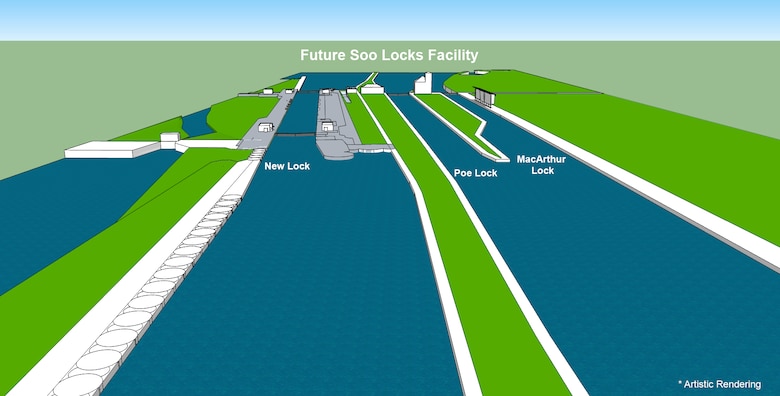DETROIT – The U.S. Army Corps of Engineers’ Detroit District is receiving $561 million in fiscal year 2022 of Infrastructure Investment and Jobs Act (IIJA) and Disaster Relief Supplemental Appropriations Act (DRSAA) funds for work in Michigan and on the Great Lakes.
IIJA operations and maintenance funds are allocated one year at a time. More funding across the Great Lakes is likely for fiscal years 23 and 24, but the determination will come at a later time.
“The IIJA funding is for major Civil Works mission areas, including navigation, aquatic ecosystem restoration and flood damage reduction,” said Detroit District Deputy District Engineer Kevin McDaniels. “The majority of money the Detroit District is receiving will fund construction of the New Lock at the Soo project.”

Nearly $479 million is slated for the Corps of Engineers’ mega project in Sault Ste. Marie, Michigan. An additional $37 million is for major rehabilitation and $4 million for other existing facility work.
“The Soo Locks are nationally critical infrastructure, and their reliability is essential to U.S. manufacturing and National Security,” said McDaniels. “A failure of the Poe Lock would have significant impacts to the U.S. economy, especially the steel industry.”
There are currently two active lock chambers at the Soo Locks facility, the Poe and MacArthur locks. The Poe Lock is the only one large enough for the 1,000-foot freighters to traverse the locks. The New Lock at the Soo is being built on the site of and replacing two inactive locks, the Davis and Sabin, and will be the same size as the Poe Lock at 1,200-feet long and 110-feet wide.
“The New Lock at the Soo will provide much needed resiliency in the Great Lakes Navigation System,” McDaniels said. “It will eliminate the single point of failure in our nation’s iron ore supply chain.”
Nearly all domestically produced high strength steel used to manufacture products like automobiles and appliances is made with taconite (iron ore) that must transit the Poe Lock.
The remaining $36.5 million will go to environmental infrastructure, navigation, continuing authority projects and other civil works programs around Michigan and in Duluth-Superior Harbor, twin ports in Duluth, Minnesota and Superior, Wisconsin.
“The remaining FY22 IIJA funding is just as critical for the Great Lakes in general,” said McDaniels. “With it the Corps of Engineers can develop, manage, restore and protect our Great Lakes water resources and infrastructure.”
Along with Buffalo District’s $24 million and Chicago Districts $93.5 million FY22 funding packages there will be a lot of important work being done in the Great Lakes region. The three Corps of Engineers Great Lakes districts are also ready to support other federal agencies with engineering support to help deliver their part of IIJA funding.
One of those key programs is the U.S. Environmental Protection Agency (USEPA)-led Great Lakes Restoration Initiative (GLRI). Launched in 2010, GLRI accelerates efforts to protect and restore the Great Lakes. Administering and implementing GLRI, USEPA has authority to receive and distribute congressionally appropriated funds to federal, state and local entities. The Corps of Engineers is committed to GLRI through programs, projects and partner collaboration with partners.
“With collaboration between Buffalo, Chicago, Detroit, our federal partners and potential additional FY 23 and 24 funding it could extend a few years. This is really exciting and beneficial for the Great Lakes region,” said McDaniels.
Overall, the Corps of Engineers received $17.1 billion IIJA funds across the nation for its Civil Works programs, projects and activities that will help the nation address current and future water resources infrastructure needs. The act’s appropriations also enable the Corps of Engineers to regulate development in waters of the United States.
The IIJA spend plan and DRSAA work plan tables can be found on the Corps of Engineers’ Civil Works Budget web page at https://www.usace.army.mil/Missions/Civil-Works/Budget/.
The IIJA was passed by the U.S. House of Representatives and President Joe Biden signed it into law in November. The Corps of Engineers submitted a detailed spend plan to Congress as required by January 14, 2022, 60 days after enactment of the legislation. The projects receiving funding were announced January 19, 2022.
- Laker Men’s Basketball Handle Kuyper 88-55 - December 23, 2024
- MYWAY Sault Bridge Brawl & NEMWA Regional Results - February 22, 2024
- Crawford County Prosecutor clears State Trooper in the fatal shooting of man earlier this month - February 23, 2023



